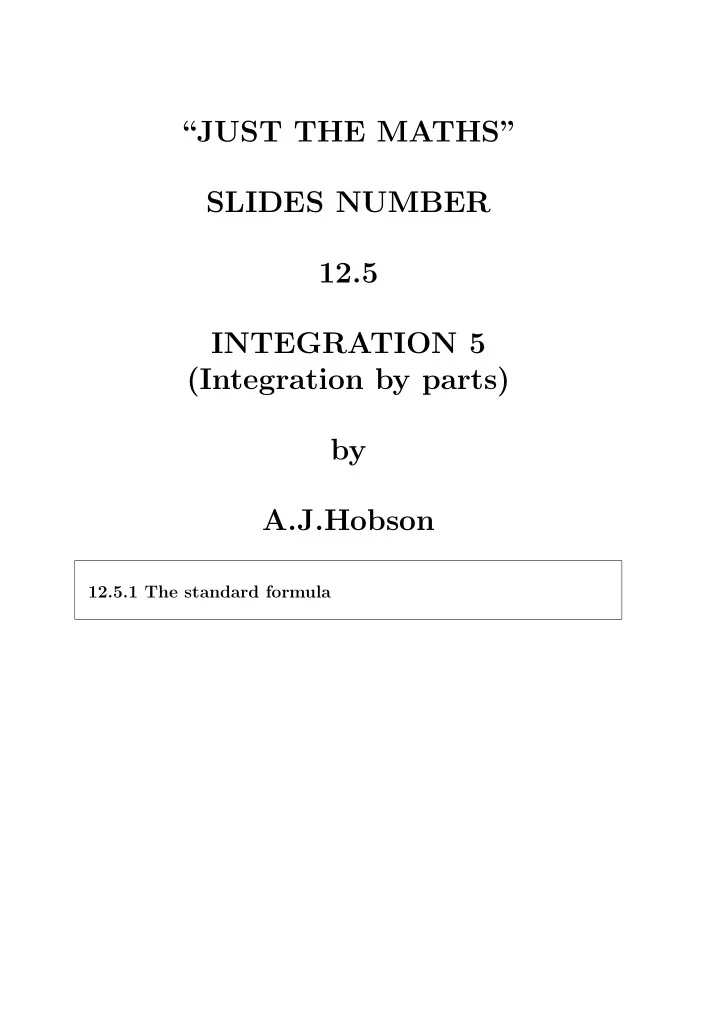

“JUST THE MATHS” SLIDES NUMBER 12.5 INTEGRATION 5 (Integration by parts) by A.J.Hobson 12.5.1 The standard formula
UNIT 12.5 - INTEGRATION 5 INTEGRATION BY PARTS 12.5.1 THE STANDARD FORMULA The method described here is for integrating the product of two functions. It is possible to develop a suitable formula by considering, instead, the derivative of the product of two functions. We consider, first, the following comparison: d d x [ uv ] = u d v d d x + v d u d x [ x sin x ] = x cos x + sin x d x d u d v d x [ uv ] − v d u d x cos x = d x [ x sin x ] − sin x d x = d x � sin x d x � x cos x d x = x sin x − � u d v � v d u d x d x = uv − d x d x = x sin x + cos x + C By labelling the product of two given functions as u d v d x, we may express the given integral in terms of another integral (hopefully simpler than the original). 1
The formula for “integration by parts” is � u d v � v d u d x d x = uv − d x d x. EXAMPLES 1. Determine the indefinite integral � x 2 e 3 x d x. I = Solution In theory, it does not matter which element of the product x 2 e 3 x is labelled as u and which is labelled as d v d x . In this case, we shall take u = x 2 and d v d x = e 3 x . Hence, I = x 2 e 3 x � e 3 x 3 . 2 x d x. 3 − That is, � xe 3 x d x. I = 1 3 x 2 e 3 x − 2 3 Using integration by parts a second time, we shall set u = x and d v d x = e 3 x . 2
Thus, xe 3 x � e 3 x I = 1 3 x 2 e 3 x − 2 3 . 1 d x . 3 − 3 The integration may now be completed to obtain I = 1 3 x 2 e 3 x − 2 9 xe 3 x + 2 27 e 3 x + C, or I = e 3 x 9 x 2 − 6 x + 2 � � + C. 27 2. Determine the indefinite integral � x ln x d x. I = Solution In this case, we choose u = ln x and d v d x = x, obtaining I = (ln x ) x 2 � x 2 2 . 1 x d x. 2 − That is, � x I = 1 2 x 2 ln x − 2 d x. 3
Hence, 2 x 2 ln x − x 2 I = 1 4 + C. 3. Determine the indefinite integral � I = ln x d x. Solution Let u = ln x and d v d x = 1 . We obtain � x. 1 I = x ln x − x d x, giving I = x ln x − x + C. 4. Evaluate the definite integral � 1 0 sin − 1 x d x. I = Solution Let u = sin − 1 x and d v d x = 1 . 4
We obtain 1 � 1 I = [ x sin − 1 x ] 1 1 − x 2 d x. 0 x. √ 0 − That is, 0 = π √ I = [ x sin − 1 x + 1 − x 2 ] 1 2 − 1 . 5. Determine the indefinite integral � e 2 x cos x d x. I = Solution We shall set u = e 2 x and d v d x = cos x. Hence, � (sin x ) . 2 e 2 x d x. I = e 2 x sin x − That is, � e 2 x sin x d x. I = e 2 x sin x − 2 Now we integrate by parts again, setting u = e 2 x and d v d x = sin x. 5
Therefore, � ( − cos x ) . 2 e 2 x d x I = e 2 x sin x − 2 − e 2 x cos x − � � . The original integral has appeared again on the right hand side to give I = e 2 x sin x − 2 − e 2 x cos x + 2 I � � . On simplification, 5 I = e 2 x sin x + 2 e 2 x cos x, so that I = 1 5 e 2 x [sin x + 2 cos x ] + C. Priority Order for choosing u 1. LOGARITHMS or INVERSE FUNCTIONS; 2. POWERS OF x ; 3. POWERS OF e . 6
Recommend
More recommend